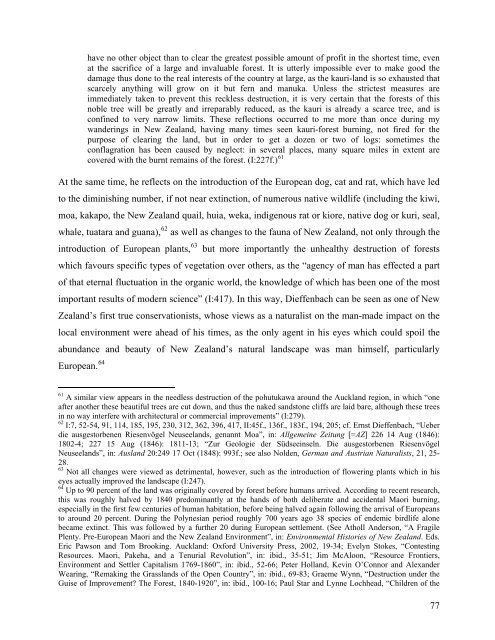General copyright and disclaimer - ResearchSpace@Auckland ...
General copyright and disclaimer - ResearchSpace@Auckland ...
General copyright and disclaimer - ResearchSpace@Auckland ...
Create successful ePaper yourself
Turn your PDF publications into a flip-book with our unique Google optimized e-Paper software.
have no other object than to clear the greatest possible amount of profit in the shortest time, even<br />
at the sacrifice of a large <strong>and</strong> invaluable forest. It is utterly impossible ever to make good the<br />
damage thus done to the real interests of the country at large, as the kauri-l<strong>and</strong> is so exhausted that<br />
scarcely anything will grow on it but fern <strong>and</strong> manuka. Unless the strictest measures are<br />
immediately taken to prevent this reckless destruction, it is very certain that the forests of this<br />
noble tree will be greatly <strong>and</strong> irreparably reduced, as the kauri is already a scarce tree, <strong>and</strong> is<br />
confined to very narrow limits. These reflections occurred to me more than once during my<br />
w<strong>and</strong>erings in New Zeal<strong>and</strong>, having many times seen kauri-forest burning, not fired for the<br />
purpose of clearing the l<strong>and</strong>, but in order to get a dozen or two of logs: sometimes the<br />
conflagration has been caused by neglect: in several places, many square miles in extent are<br />
covered with the burnt remains of the forest. (I:227f.) 61<br />
At the same time, he reflects on the introduction of the European dog, cat <strong>and</strong> rat, which have led<br />
to the diminishing number, if not near extinction, of numerous native wildlife (including the kiwi,<br />
moa, kakapo, the New Zeal<strong>and</strong> quail, huia, weka, indigenous rat or kiore, native dog or kuri, seal,<br />
whale, tuatara <strong>and</strong> guana), 62 as well as changes to the fauna of New Zeal<strong>and</strong>, not only through the<br />
introduction of European plants, 63 but more importantly the unhealthy destruction of forests<br />
which favours specific types of vegetation over others, as the “agency of man has effected a part<br />
of that eternal fluctuation in the organic world, the knowledge of which has been one of the most<br />
important results of modern science” (I:417). In this way, Dieffenbach can be seen as one of New<br />
Zeal<strong>and</strong>’s first true conservationists, whose views as a naturalist on the man-made impact on the<br />
local environment were ahead of his times, as the only agent in his eyes which could spoil the<br />
abundance <strong>and</strong> beauty of New Zeal<strong>and</strong>’s natural l<strong>and</strong>scape was man himself, particularly<br />
European. 64<br />
61<br />
A similar view appears in the needless destruction of the pohutukawa around the Auckl<strong>and</strong> region, in which “one<br />
after another these beautiful trees are cut down, <strong>and</strong> thus the naked s<strong>and</strong>stone cliffs are laid bare, although these trees<br />
in no way interfere with architectural or commercial improvements” (I:279).<br />
62<br />
I:7, 52-54, 91, 114, 185, 195, 230, 312, 362, 396, 417, II:45f., 136f., 183f., 194, 205; cf. Ernst Dieffenbach, “Ueber<br />
die ausgestorbenen Riesenvögel Neuseel<strong>and</strong>s, genannt Moa”, in: Allgemeine Zeitung [=AZ] 226 14 Aug (1846):<br />
1802-4; 227 15 Aug (1846): 1811-13; “Zur Geologie der Südseeinseln. Die ausgestorbenen Riesenvögel<br />
Neuseel<strong>and</strong>s”, in: Ausl<strong>and</strong> 20:249 17 Oct (1848): 993f.; see also Nolden, German <strong>and</strong> Austrian Naturalists, 21, 25-<br />
28.<br />
63<br />
Not all changes were viewed as detrimental, however, such as the introduction of flowering plants which in his<br />
eyes actually improved the l<strong>and</strong>scape (I:247).<br />
64<br />
Up to 90 percent of the l<strong>and</strong> was originally covered by forest before humans arrived. According to recent research,<br />
this was roughly halved by 1840 predominantly at the h<strong>and</strong>s of both deliberate <strong>and</strong> accidental Maori burning,<br />
especially in the first few centuries of human habitation, before being halved again following the arrival of Europeans<br />
to around 20 percent. During the Polynesian period roughly 700 years ago 38 species of endemic birdlife alone<br />
became extinct. This was followed by a further 20 during European settlement. (See Atholl Anderson, “A Fragile<br />
Plenty. Pre-European Maori <strong>and</strong> the New Zeal<strong>and</strong> Environment”, in: Environmental Histories of New Zeal<strong>and</strong>. Eds.<br />
Eric Pawson <strong>and</strong> Tom Brooking. Auckl<strong>and</strong>: Oxford University Press, 2002, 19-34; Evelyn Stokes, “Contesting<br />
Resources. Maori, Pakeha, <strong>and</strong> a Tenurial Revolution”, in: ibid., 35-51; Jim McAloon, “Resource Frontiers,<br />
Environment <strong>and</strong> Settler Capitalism 1769-1860”, in: ibid., 52-66; Peter Holl<strong>and</strong>, Kevin O’Connor <strong>and</strong> Alex<strong>and</strong>er<br />
Wearing, “Remaking the Grassl<strong>and</strong>s of the Open Country”, in: ibid., 69-83; Graeme Wynn, “Destruction under the<br />
Guise of Improvement? The Forest, 1840-1920”, in: ibid., 100-16; Paul Star <strong>and</strong> Lynne Lochhead, “Children of the<br />
77















